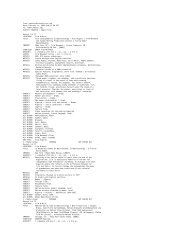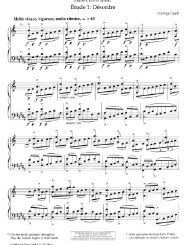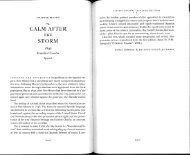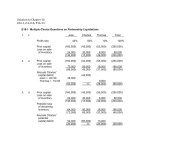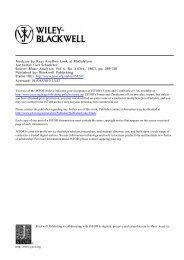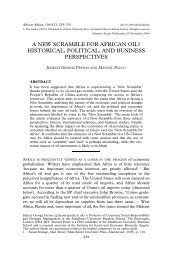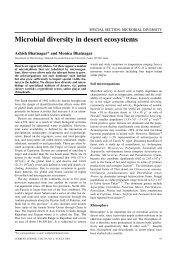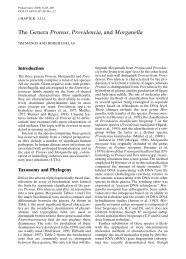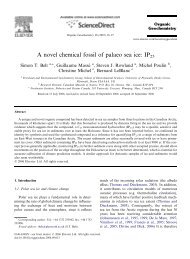The Genus Serratia
The Genus Serratia
The Genus Serratia
Create successful ePaper yourself
Turn your PDF publications into a flip-book with our unique Google optimized e-Paper software.
CHAPTER 3.3.11 <strong>The</strong> <strong>Genus</strong> <strong>Serratia</strong> 235<br />
Table 7. Identification of <strong>Serratia</strong> rubidaea biotypes. a<br />
Trait<br />
Biotype b<br />
B1 B2 B3<br />
Growth on:<br />
Histamine v − +<br />
D-Melezitose − + +<br />
D-Tartrate + − v<br />
Tricarballylate − v −<br />
Voges-Proskauer (O’Meara) + − v<br />
Lysine decarboxylase + + −<br />
Malonate (Leifson) + + −<br />
a Symbols as in Table 4.<br />
b Biotype B1 corresponds to the subspecies designated as<br />
S. rubidaea subsp. burdigalensis; B2 to S. rubidaea subsp.<br />
rubidaea; and B3 to S. rubidaea subsp. colindalensis.<br />
Unpublished observations, F. Grimont and P. A. D. Grimont.<br />
Table 8. Identification of <strong>Serratia</strong> odorifera biotypes. a<br />
Trait<br />
a Symbols as in Table 4.<br />
b <strong>The</strong> type strain corresponds to biotype 1.<br />
c Some strains were positive in 3–7 days.<br />
Biotype<br />
1 b 2<br />
Growth on:<br />
m-Erythritol − +<br />
L-Fucose v +<br />
D-Raffinose + −<br />
Sucrose + −<br />
D-Tartrate + −<br />
Ornithine decarboxylase + −<br />
Acid from sucrose + −<br />
Acid from raffinose + − c<br />
Table 9. Identification of <strong>Serratia</strong> entomophila biotypes. a<br />
Trait<br />
Biotype<br />
1 b 2<br />
Growth on:<br />
D-Arabitol + −<br />
L-Arabitol − +<br />
D-Malate − v<br />
Quinate + v<br />
D-Xylose − +<br />
a Symbols as in Table 4.<br />
b <strong>The</strong> type strain corresponds to biotype 1.<br />
Biotyping of S. marcescens is epidemiologically useful (Grimont<br />
and Grimont, 1978b, Sifuentes-Osornio et al., 1986).<br />
Pigmentation occurs only in five S. marcescens biotypes: A1a,<br />
A1b, A2a, A2b, and A6. <strong>The</strong> 13 other S. marcescens biotypes<br />
correspond to nonpigmented strains: A3a, A3b, A3c, A3d,<br />
A4a, A4b, A5, A8a, A8b, A8c, TCT, TT, and TC. Biotypes TT<br />
and TC are rarely found and their ecological-epidemiological<br />
significance is unknown. Nonpigmented biotypes A3abcd<br />
and A4ab are ubiquitous, whereas nonpigmented biotypes<br />
A5, A8abc, and TCT seem restricted to hospitalized patients<br />
(these biotypes can however be isolated from sewagepolluted<br />
river water). Pigmented biotypes are ubiquitous.<br />
Minor and Sauvageot-Pigache, 1981; Le Minor<br />
et al., 1983; Sedlak et al., 1965; Traub, 1981, 1985;<br />
Traub and Fukushima, 1979b; Traub and Kleber,<br />
1977). <strong>The</strong> present system consists of 24 somatic<br />
antigens (O1 to O24) and 26 flagellar antigens<br />
(H1 to H26). Serotyping of S. marcescens is not<br />
easy. Cross-reactions occur between O antigens<br />
2 and 3 (the common antigen is referred to as<br />
Co/2, 3); 6 and 7; 6, 12, and 14; and 12, 13, and<br />
14 (the common antigen is referred to as Co/12,<br />
13, 14). Some strains seem to have more than one<br />
O-factor (e.g., O3,21). Cross-reactions between<br />
O6 and O14 are so extensive that the epidemiological<br />
distinction between these two<br />
antigens (now referred to as O6/O14) was<br />
abandoned.<br />
<strong>The</strong> accuracy of the O-agglutination test with<br />
boiled antigens has been questioned (Gaston et<br />
al., 1988; Gaston and Pitt, 1989a). Immunoblotting<br />
with electrophoresced lipopolysaccharide<br />
(LPS) antigens showed that O-agglutining sera<br />
often reacted with a heat-stable surface antigen<br />
rather than with LPS. This heat-stable surface<br />
antigen masks the expression of O-specific LPS<br />
antigens. Gaston and Pitt (1989b) proposed a<br />
simple dot enzyme immunoassay (dot EIA) that<br />
could offer greater accuracy than agglutination<br />
tests for serotype identification. Most strains<br />
possess distinct acidic polysaccharides of microcapsular<br />
origin. Oxley and Wilkinson (1988a)<br />
have shown that the O13 antigen is a microcapsular,<br />
acid polymer, rather than an integral part<br />
of the lipopolysaccharide. No high-molecular<br />
weight LPS corresponding to O-side chain material<br />
was detected in O-serogroup reference strain<br />
O11 or O13 (Gaston and Pitt, 1989a). <strong>The</strong> O6/<br />
O14 antigen is a partially acetylated acidic<br />
glucomannan (Brigden and Wilkinson, 1985).<br />
Three different neutral polymers (O-side chain<br />
polysaccharides) have been found in three O14<br />
strains. Each of these polymers has been shown<br />
to occur also in strains of serogroups O6, O8, or<br />
O12. <strong>The</strong> polymer with a disaccharide repeatingunit<br />
of D-ribose and 2-acetamido-2-deoxy-Dgalactose<br />
present in the O12 reference strain, the<br />
O14:H9 reference strain, and in a O13:H7 reference<br />
strain all correspond to the Co/12,13,14<br />
antigen shared by these strains (Brigden et al.,<br />
1985; Brigden and Wilkinson, 1983; Oxley and<br />
Wilkinson, 1988b).<br />
To overcome the tediousness of measuring<br />
flagellar agglutination, an immobilization test in<br />
semisolid agar has been described for determination<br />
of H antigens (Le Minor and Pigache, 1977).<br />
<strong>The</strong> technique is facilitated by the use of pools<br />
of nonabsorbed sera. No anti-H:9 serum is<br />
needed in pools, as bacteria with H:9 antigen are<br />
immobilized by anti-H:8 and anti-H:10 sera.<br />
Once the unknown strain is immobilized by a<br />
serum pool, corresponding individual sera are



